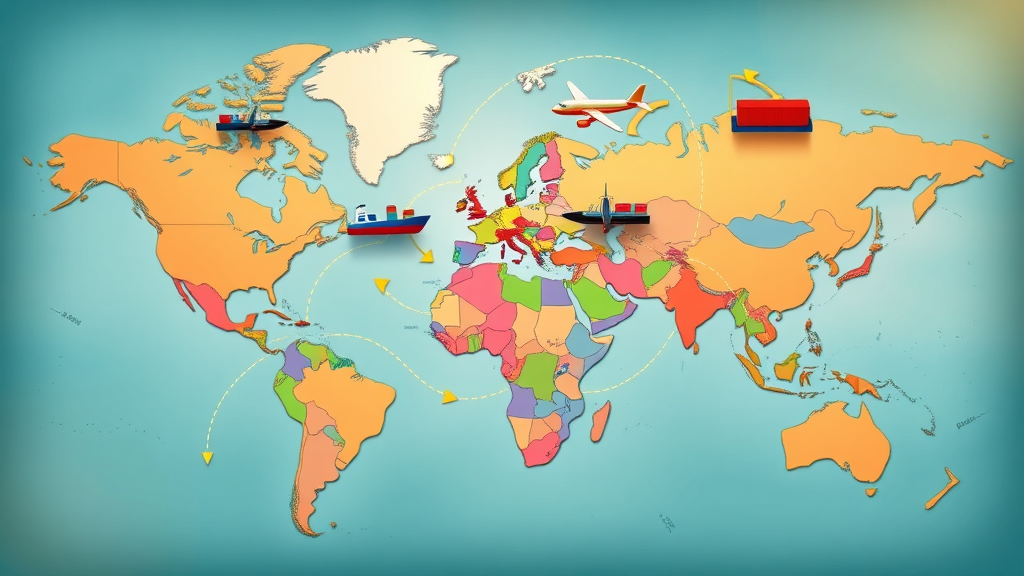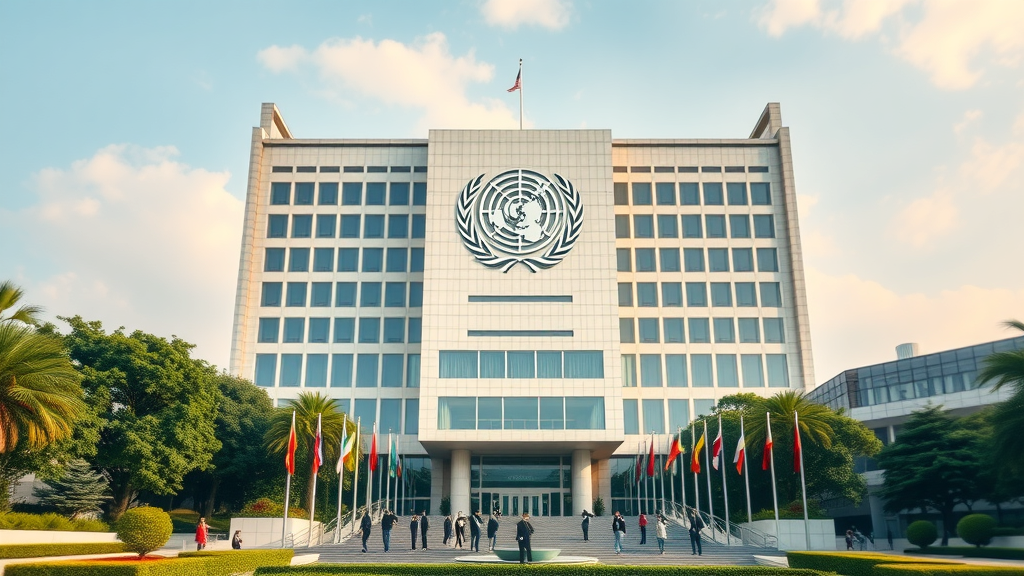Every day, global trade moves trillions of dollars’ worth of goods and services across ocean waves and through digital platforms—connecting people, powering economies, and opening doors for innovation worldwide. Did you know that over 80% of the world’s goods are moved by sea, connecting continents and shaping economies every day? This article reveals the mechanisms behind world trade’s incredible scale and explores how business leaders, policymakers, and entrepreneurs can capitalize on new opportunities, overcome challenges, and thrive in the ever-evolving international marketplace.
Unveiling the Power of Global Trade: Surprising Facts and International Impacts
"Did you know that over 80% of the world’s goods are moved by sea, connecting continents and shaping economies every day?"

The true power of global trade often escapes our daily notice. Its impact goes far beyond store shelves or online listings. Trade in goods and services intricately links manufacturers, farmers, and tech companies from nearly every country and region—including East Asia , the Middle East , Latin America , and more. Because over 80% of these goods cross oceans, the world’s largest economies and smallest emerging markets remain interconnected through vast global supply chains. For example, when a shipping disruption occurs in one port in East Asia, ripple effects can be felt by retailers and consumers in the United States and Europe within days.
International trade doesn’t just move products— it shapes national GDPs, supports millions of jobs, and drives technological progress. As trade volumes have soared in recent years, so have opportunities for businesses to reach global customers, source materials cost-effectively, and innovate through collaboration. Trade organizations, regulatory bodies, and agreements also play pivotal roles in stabilizing international economic relations, minimizing trade restrictions, and protecting the interests of countries and corporations alike. Understanding these mechanisms is essential for anyone seeking to leverage the global economy for growth and resilience.
- Insight into international and world trade mechanisms
- How supply chain shifts influence world markets
- The essential role of trade organizations and regulatory frameworks
- Expert commentary on free trade and modern trade challenges
- Actionable takeaways for business leaders and entrepreneurs
Global Trade: Definition, Scope, and Significance in International Trade
| Aspect | Global Trade | International Trade | World Trade |
|---|---|---|---|
| Scope | Entire global market | Between nations | Aggregate global |
| Main Players | Nations, businesses | Governments, firms | WTO members |
| Key Focus | Integration | Agreements, policies | Regulation |

Understanding Global Trade: Key Definitions
Global trade encompasses the exchange of goods, services, and capital across international borders on a massive scale. Unlike domestic commerce, global trade involves a complex web of nations, multinational businesses, and global organizations coordinating imports and exports under a wide variety of rules and agreements. While international trade typically refers to commerce between two or more countries, “global trade” signals a fully interconnected marketplace shaped by cumulative activities worldwide.
In the modern world trade system, countries leverage their unique resources and competitive strengths (known as comparative advantage ) to maximize their economic impact. These dynamics are influenced by trade organizations, regulatory entities, and evolving geopolitical factors. The benefits of participating in global trade reach far beyond corporations— fueling economic growth, promoting technological sharing, and enhancing consumer choice on every continent.
International Trade and World Trade: The Critical Differences
While the terms “ global trade ,” “ international trade ,” and “ world trade ” are often used interchangeably, they feature key differences. International trade refers to the exchange of goods and services specifically between countries. World trade aggregates all cross-border transactions and is measured by the sum total of imports and exports worldwide, including direct foreign investment and global supply chains.
These distinctions matter for business leaders, as each concept entails unique policies, trading partners, and organizational frameworks. Recognizing the scope and focus of each term allows companies to tailor their market entry and expansion strategies, comply with different regulatory environments, and better navigate the challenges of volatile trade policies and economic cycles.
"Global trade isn't just about goods and services—it’s about opportunities, competition, and global collaboration."
The Role of Trade Organizations in Shaping Global Markets
World Trade Organization: Influence and Governance

The World Trade Organization (WTO) stands as the principal regulator of international trade. Founded to foster stability, fairness, and growth in the global trading system , it sets the rules that govern tariff practices, dispute resolution, and trade negotiations among member countries. The WTO influences not only the world's largest economies—like the United States and United Kingdom —but also supports developing states aiming to access the global market.
By mediating disputes and facilitating new trade agreements, the WTO plays a critical role in ensuring a level playing field for all. In recent years, debates over trade restrictions, fair labor practices, and climate considerations have shaped the organization’s agenda—pushing it to adapt its frameworks to modern global challenges. For entrepreneurs and policy experts alike, understanding the influence of the WTO is essential for predicting shifts in world trade and crafting successful cross-border strategies.
Other Leading Trade Organizations and Their Impact on International Trade
Beyond the WTO, several regional and sector-specific trade organizations actively shape the direction of global commerce. Examples include NAFTA/USMCA in North America, the European Union trade system, and APEC in East Asia and the Pacific. These entities establish trade regulations, promote economic integration, and often address market access barriers unique to member regions.
For business leaders, having a clear understanding of these organizations can be a game-changer—helping them anticipate regulation changes, identify emerging opportunities, and mitigate risks related to trade disputes or sudden shifts in policy. Specialized agencies also facilitate foreign direct investment, technology transfers, and the development of international standards, ultimately boosting efficiency and competitiveness in global supply chains.
How the United States and United Kingdom Propel Global Trade
United States: Leadership in World Trade, Imports and Exports

The United States remains a powerhouse in global trade , acting as both one of the world’s largest exporters and importers. Its massive domestic market, technological innovation, and global network of trading partners allow it to influence not only the world economy but also regulatory standards and consumer trends. In recent years, the US has taken a leading role in negotiating free trade agreements, enforcing intellectual property rules, and setting digital trade benchmarks.
Industries from tech to agriculture benefit from America’s global supply chain integration. However, challenges exist, including ongoing trade disputes, tariff fluctuations, and shifting political priorities. Business leaders must remain agile, leveraging free trade opportunities while navigating the ever-changing landscape set by Department of State advisories and new world trade agreements.
United Kingdom: Navigating Post-Brexit Challenges and Comparative Advantage
The United Kingdom presents a fascinating case study in modern world trade. Since leaving the European Union, the UK has had to renegotiate trade deals, redefine its comparative advantage, and seek new trading partners globally. The UK’s strengths lie in sectors like financial services, pharmaceuticals, and creative industries, making it a valuable trading partner for both developed and emerging economies.
While post-Brexit uncertainties have created unique hurdles—like revised tariffs, new customs checks, and regulatory divergence—the UK’s adaptability demonstrates the importance of strategic planning, supply chain diversification, and building cross-border partnerships for sustained success in international trade.
Free Trade and the Supply Chain: Drivers and Disruptors in Global Trade
Free Trade Agreements: Opportunities and Controversies

Free trade agreements (FTAs) eliminate barriers such as tariffs and quotas, enabling a smoother flow of goods and services across borders. These agreements open up lucrative export markets and deliver cost efficiencies for multinational businesses, whether in East Asia , the Middle East , or Latin America . Iconic FTAs—including NAFTA/USMCA and the European Single Market—have shaped entire industries and transformed global supply chains.
Yet, FTAs often spark controversy. Concerns about job losses, wage pressures, environmental impact, and economic inequality stoke ongoing policy debates in the United States , United Kingdom , and elsewhere. Business leaders must weigh the opportunities of open markets against the complexities of compliance, political risk, and shifting global supply dynamics.
How Global Supply Chain Shifts Reshape International Trade
The COVID-19 pandemic underscored the fragility and importance of global supply chains . Disruptions in manufacturing hubs—especially in sectors dependent on imported components from East Asia or Latin America—caused widespread shortages and delivery delays, rewriting the rules for international trade. As companies reevaluate supplier relationships, diversify sourcing, and invest in digital tracking, the resilience and flexibility of supply chains have taken center stage.
As quoted by a leading logistics expert,
"Supply chain resilience is the new currency of global competition—and disruptions rewrite the rulebook."
Comparative Advantage: The Engine Behind Imports and Exports
Real-World Examples of Comparative Advantage Empowering Global Trade
| Country | Major Export | Comparative Advantage Factor |
|---|---|---|
| Brazil | Coffee | Climate, resource abundance |
| Germany | Automobiles | Engineering expertise |
| United States | Tech Services | Innovation, capital access |

Comparative advantage is the engine that powers imports and exports worldwide. Countries thrive by specializing in industries where they hold natural or developed advantages—whether it’s Brazil’s ideal climate for coffee, Germany’s precision engineering in automobiles, or the United States’ dominance in digital and tech-related services. This specialization benefits not only individual nations but also produces greater overall efficiency in the world economy.
Recognizing and leveraging comparative advantage allows nations to export their best products and import those that can be produced more efficiently elsewhere. In recent years, advances in transportation, digital trade platforms, and global investment have fast-tracked international economic integration, enabling even small and emerging economies to carve out new opportunities in the competitive landscape of world trade.
Business Leaders in Global Trade: Strategies for Success
Key Lessons from World Trade Pioneers

Business leaders who achieve global trade excellence share several common strategies. They diversify their supply chains to reduce risk, master the intricacies of regulatory environments, and foster robust partnerships with firms and governments worldwide. Forward-thinking executives also harness the power of digital trade platforms to streamline operations and tap into new markets.
From leveraging their company’s comparative advantage to staying agile in the face of regulatory uncertainty, these pioneers demonstrate how proactive planning and informed decision-making can unlock global opportunities. Companies that invest in compliance, cross-cultural understanding, and technological innovation consistently outperform competitors and remain resilient in the world’s rapidly shifting trade environment.
- Diversification of supply chains
- Mastering regulatory environments
- Building global partnerships
- Leveraging digital trade platforms
Challenges and Trends: The Future of Global Trade
Navigating Geopolitics, Tariffs, and Trade Policy Volatility

The future of global trade will be shaped by dynamic and often unpredictable forces. Tariff battles, shifting alliances, and evolving regulatory regimes—whether between the United States , China, or post-Brexit United Kingdom —demand agility from businesses and governments alike. In recent years, rising protectionism, trade restrictions, and supply chain realignments have forced companies to adapt quickly or risk losing market share.
Trade policy volatility remains a key risk factor. Proactive companies closely monitor developments at the World Trade Organization , track geopolitical events, and maintain contingency plans to guard against sudden market shifts or diplomatic disputes. Navigating these risks requires timely data, strategic partnerships, and a willingness to pivot in a complex, interconnected trading system.
Sustainability, Technology, and Evolving Trade Models
Technology is rapidly driving change in global trade, from blockchain-powered transparency in supply chains to big data analytics optimizing the flow of goods and services. At the same time, sustainability has become a non-negotiable demand among consumers, regulators, and investors. Businesses leading the way in environmental responsibility—by reducing emissions, sourcing ethically, and innovating greener logistics—are setting new international standards.
As one expert puts it:
"Tomorrow’s world trade winners will be those who adapt to rapid changes in regulation, technology, and consumer demand."
People Also Ask: What is the meaning of global trade?
Answer: Global trade refers to the exchange of goods, services, and capital across international borders involving countries, businesses, and organizations worldwide.

People Also Ask: What are 5 examples of global trade?
Answer: Five notable examples of global trade include: 1. The export of automobiles from Germany to the United States, 2. The import of electronics from China to Brazil, 3. Oil sales from Saudi Arabia to Japan, 4. Agricultural exports from the United States to Europe, 5. Textiles supplied from Bangladesh to global markets.
People Also Ask: What does a global trader do?
Answer: A global trader manages buying and selling goods and services across different countries, navigating legal, financial, and logistical complexities while leveraging market opportunities.
People Also Ask: Why is global trade important?
Answer: Global trade drives economic growth, increases consumer choices, enables efficient resource use, promotes international cooperation, and helps nations achieve technological advancement.
FAQs about Global Trade: Crucial Insights for Business Leaders
- How does global trade impact local economies? Global trade fuels local economic growth by providing access to new markets, fostering innovation, and enabling local companies to scale internationally. It also bolsters employment in export-driven sectors and enhances consumer choice by making products from all over the world readily available.
- What risks do businesses face in international trade? Companies engaged in global trade must navigate risks like fluctuating exchange rates, complex regulatory compliance, political instability, and supply chain interruptions. Strategic risk management and diversification can help mitigate many of these challenges.
- Which sectors are most affected by disruptions in world trade? Manufacturing, automobile, electronics, agriculture, and retail sectors are particularly sensitive to global trade disruptions. Delays in supply chains or sudden policy changes can significantly impact these industries’ profitability and stability.
Why Embracing Global Trade is More Important Than Ever for World Trade Success
Expert opinions on seizing global market opportunities in international trade

As international barriers recede and digitalization accelerates, businesses that embrace global trade will unlock new opportunities, reach wider markets, and achieve lasting competitive advantage. In this rapidly shifting world economy, agility, foresight, and a willingness to adapt are the keys that unlock success on the world trade stage.
For personalized strategies on navigating global trade, call 203-271-7991 for more information.
Key Takeaways and Action Steps: Achieving Success in Global Trade
Checklist for global trade readiness:
- Assess your supply chain vulnerabilities
- Study major international trade regulations
- Build relationships with key trade organizations
- Identify your business’s comparative advantage
Further Learning: Recommended Resources and Thought Leadership in Global Trade
Top suggested books, podcasts, and industry journals for mastering world trade and international trade trends
- Books: "The World Is Flat" by Thomas L. Friedman; "Why Nations Fail" by Daron Acemoglu & James A. Robinson; "Poor Economics" by Abhijit V. Banerjee & Esther Duflo.
- Podcasts: "Trade Talks," "The Indicator from Planet Money," "World Trade Organization Podcast."
- Journals: The Economist – International Trade Section, World Trade Review, Journal of International Economics.
Conclusion
Take proactive steps to assess your business’s readiness, tap into expert advisory, and engage with global trade organizations to secure a brighter, more resilient future in world trade.
Staying ahead in global trade also means keeping up with the latest shifts and best practices. For actionable tips on monitoring market changes and adapting your import-export strategies, explore this guide on how to stay updated with global trade trends .
As you continue to refine your approach to global trade, consider how broader economic policies and emerging trends can influence your long-term strategy. Delving into the latest trade policy insights from the Economic Report of the President can provide a strategic edge, helping you anticipate regulatory changes and seize new opportunities. By expanding your knowledge beyond day-to-day operations, you’ll be better equipped to navigate uncertainty and drive sustainable growth in the international marketplace. Let your next step be a deeper dive into the forces shaping tomorrow’s world trade landscape.
Global trade is a complex and dynamic field, and staying informed is crucial for success. To deepen your understanding, consider exploring the following resources:
-
The World Trade Organization (WTO) offers comprehensive data and analysis on international trade through its Global Trade Data Portal . This resource provides up-to-date statistics and insights into global trade patterns, helping businesses and policymakers make informed decisions.
-
For a detailed examination of how global value chains influence economic development, the World Bank’s World Development Report 2020: Trading for Development in the Age of Global Value Chains is invaluable. This report analyzes the role of global value chains in fostering growth and reducing poverty, offering strategies for countries to integrate effectively into the global economy.
By engaging with these authoritative sources, you can gain a deeper understanding of the mechanisms driving global trade and identify strategies to navigate its challenges and opportunities.
 Add Row
Add Row  Add
Add 




Write A Comment